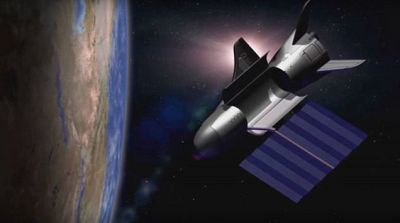The robotic craft has logged nearly 719 days of orbital spaceflight, and counting.
The U.S. Air Force's X-37B space plane just broke its spaceflight-duration record.
At 6:43 a.m. EDT (1043 GMT) today (Aug. 26), the robotic X-37B sailed past the program mark of 717 days, 20 hours and 42 minutes, which was set by the previous mission, known as Orbital Test Vehicle 4 (OTV-4).
The current mission, OTV-5, began on Sept. 7, 2017, with a liftoff atop a SpaceX Falcon 9 rocket. It's unclear what the space plane is doing up there now, or what it has done on past flights; X-37B missions are classified, and the Air Force therefore tends to speak of the vehicle and its activities in general terms.
Related: The X-37B Space Plane: 6 Surprising Facts
"The primary objectives of the X-37B are twofold; reusable spacecraft technologies for America's future in space and operating experiments which can be returned to, and examined, on Earth," Air Force officials wrote in theX-37B fact sheet.
"Technologies being tested in the program include advanced guidance, navigation and control, thermal protection systems, avionics, high temperature structures and seals, conformal reusable insulation, lightweight electromechanical flight systems, advanced propulsion systems, advanced materials and autonomous orbital flight, reentry and landing," the officials added.
The test campaign seems to involve pushing the X-37B's endurance, because each of the five missions has lasted longer than its predecessor. OTV-1 launched in April 2010, and returned to Earth that December after 224 days in space. OTV-2 ran for 468 days, from March 2011 through June 2012. OTV-3 launched in December 2012 and landed in October 2014, racking up 675 days of spaceflight. And OTV-4 landed in May 2017 after nearly 718 days in orbit.
Technology
OTV-5 is nowhere near the overall spaceflight-duration record, however. Earth-observation and communications satellites commonly operate for five years or more, as do robotic planetary explorers. NASA's Curiosity rover has been exploring Mars for more than seven years, for example, and the agency's twin Voyager probes are still going strong in interstellar space more than four decades after their launches.
The Air Force has at least two X-37Bs, both of which were built by Boeing. The solar-powered vehicles look like NASA's old space shuttle orbiters, but are much smaller; an X-37B could fit entirely within the shuttle's cavernous payload bay.
Each X-37B measures 29 feet (8.8 meters) long by 9.6 feet (2.9 m) tall, with a wingspan of about 15 feet (4.6 m). The space plane's payload bay is about the size of a pickup-truck bed.
Like the space shuttle, the winged X-37B launches vertically and lands on a runway. All five X-37B missions have lifted off from Florida's Space Coast. The first three landings took place at Vandenberg Air Force Base in California, but OTV-4 touched down at the Shuttle Landing Facility at NASA's Kennedy Space Center in Florida.
- US Air Force's Secretive X-37B Space Plane (Infographic)
- In Photos: SpaceX Launches X-37B Space Plane, Lands Falcon 9 Rocket
- Gallery: Declassified US Spy Satellite Photos & Designs
Mike Wall's book about the search for alien life, "Out There" (Grand Central Publishing, 2018; illustrated byKarl Tate), is out now. Follow him on Twitter @michaeldwall. Follow us on Twitter@Spacedotcom orFacebook.












